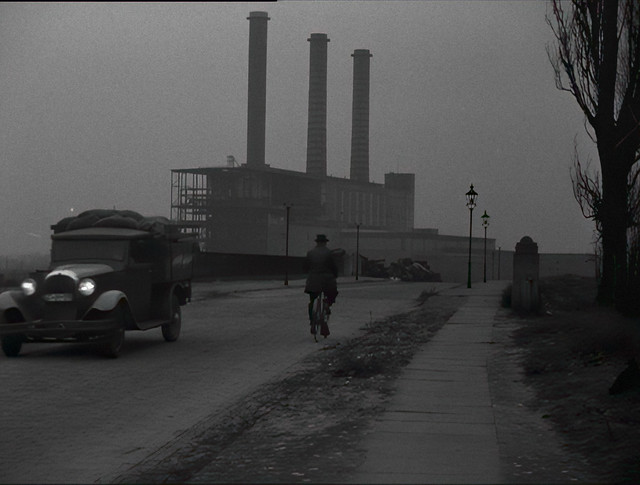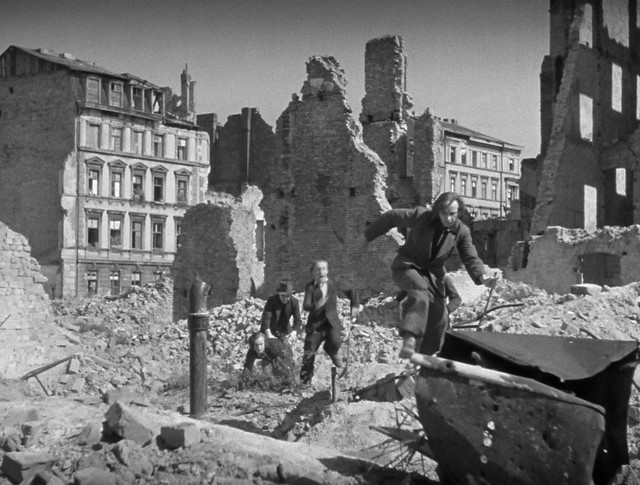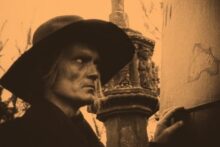At least twice, Germany has had among the most influential and important mainstream film industries in the world. First, famously, between 1919 and 1933, German directors, in what was called, not always accurately, ‘German Expressionism’, created the modern horror film with F.W Murnau’s Nosferatu and Robert Weine’s Cabinet of Dr Caligari, the modern science fiction film with Fritz Lang’s Metropolis, the morally ambiguous thriller with M, the film-essay with Walther Ruttman’s Berlin – Symphony of the Great City, and invented the indie film on the side, with Slatan Dudow and Bertolt Brecht’s explicitly Communist Kuhle Wampe, or Robert Siodmak, Edgar G Ulmer and Billy Wilder’s impromptu People on Sunday. G.W Pabst’s Pandora’s Box and Diary of a Lost Girl invented (female) Goths. The German film diaspora created by Nazism would revolutionise American cinema in the 40s, particularly in the Film Noir, a largely German émigré invention. Decades later, the ‘New German Cinema’ of Werner Herzog, Rainer Werner Fassbinder and Wim Wenders, among others, took Hollywood genre cliches and bent and reshaped them into something fresh, experimental and politically radical, while the likes of Harun Farocki, Ulrike Ottinger and Alexander Kluge made formally extreme, theoretically dense, often extraordinary work on the fringes of the film industry. But could you name a German film made between the Nazi seizure of power in 1933 and 1966, the year of the first major feature of the New German Cinema, (Alexander Kluge’s Yesterday Girl)?
You might mention two Nazi films – Leni Riefenstahl’s Triumph of the Will, a tedious slog overrated by people who haven’t seen it, and her more impressive Olympia – or maybe the very late work of a rare returnee, Fritz Lang, like The Thousand Eyes of Dr Mabuse. But mostly, the German cinema of the later 30s, the 40s, the 50s and most of the 60s is a black hole to non-Germans. Within that, however, there are a few well-kept secrets.
Post-war Germany had, of course, two competing national cinemas, one in the West and one in the East. The one which lost out in the historical contest is that of East Germany, which reshaped the pre-war conglomerate UFA into the state-owned DEFA, which is today a minor cult among Germanophone film enthusiasts. There are several ways of telling its history – Eureka recently released an (already sold out) limited edition box set on their lavish science fiction films. But its obscurity has an easy explanation. East German cinema’s ‘golden age’ in terms of quality came in a new wave of films in the mid-1960s that were loose, ironic, sexy and often bleak, like Frank Beyer’s Trace of Stones, Kurt Maetzig’s The Rabbit is Me, or Jürgen Böttcher’s Born in ‘45; all of which were banned, sometimes before completion, meaning that a new wave – which might have ranked with that in Poland or Czechoslovakia – was crushed with staggering speed.
The easy explanation for why thirty years of German cinema presented such a miserable record, aside from East German censorship and West German conformism, is that what had happened to it as a society was so unspeakable that it was so much easier to retreat into escapism and propaganda than to reckon with the scale of the guilt. But post-war German cinema actually begins with an attempt to confront German society with its crimes: DEFA’s ‘rubble films’ sequence, which is the subject of the new Eureka boxset Wrack and Ruin, presenting five East German films from the first three years after the defeat of German fascism. ‘Rubble films’ were sponsored by the Soviet occupiers of Eastern Germany and East Berlin as part of the project of de-Nazification, with the theory being that mass market film was uniquely suited to forcing ordinary Germans to understand and come to terms with what they had done. It was a brief moment, necessarily compromised – most of the directors and stars had worked throughout the Nazi period, with few, if any, returned emigres working in ‘rubble films’ – but the films are fascinating as attempts to make antifascist commercial blockbusters, in a devastated society that would have preferred to think about almost anything else.

Wolfgang Staudte’s The Murderers Are Among Us (1946) is the hit of the box set, and by far the best known of these. Many people interested in German cinema will have seen it (certainly, it’s the only one of the box I had seen before), and will have been impressed by how this melodrama in an almost flattened Berlin moonscape combines Expressionism, noir, and a subtle political critique of the way in which many war criminals tried to dissolve back into German society, often living side-by-side with their former victims. The people who made it took their own guilt with them. Staudte, the director, had worked as an actor on Jew Suss, the notorious antisemitic propaganda film whose director, Viet Harlan, was tried at Nuremberg for his contribution to legitimising the Holocaust. The ambiguities of the title are deliberate – it could equally have been phrased ‘we are the murderers’, were it not for the fact that its heroine, a concentration camp survivor, is an unambiguous victim.
DEFA films were not rarefied experiments – they were meant to be watched by millions, or the de-Nazification effort would have been pointless, limited only to the politically and aesthetically converted. How much this could lend itself to quite conventional cinema is revealed by Police Raid (1947), directed by Werner Klingler, a journeyman who had worked in Nazi Germany, in Hollywood, and would subsequently work in both Germanies and again in the USA. It’s slick noir, all curtains and frosted windows, femmes fatales and jazz, murk and cops, set in and around the Alibaba, a seedy nightclub connected with the black market. It is a decent enough thriller, with Harry Frank as a superb Langian villain, with slicked hair and cheekbones you could cut yourself on, but it is more interesting when it leaves the studio into the rubble itself.
There is one riveting scene that begins with a tracking shot through the black market outside the Reichstag, capturing harried faces, dubious goods, and the skeletal remains of the city, with brief vignettes of ordinary people and their families coping with the chaos (“mummy,” asks one child, baffled at some of the goods on sale – “what’s chocolate?”). It might have been funded, ultimately, by Stalin’s USSR, but it’s a world without heroes. In dubious bars, Soviet propaganda posters implore people to rebuild Berlin, or to join the socialist youth organisation, but ‘Deutsches Reich’ information signs are still on all the railway stations. At moments, Police Raid promises to turn into The Third Man as if Harry Lime made it himself, but it pulls its punches, clearly unwilling to take its criticisms of German society too far.

There isn’t that much actual ‘rubble’ in some of these films – it is moral rather than figurative. Two historical dramas attempted to trace the roots and rise of Nazism through melodrama and the police procedural. The latter example, The Blum Affair (1948) is the better of the two historical films: a stagey, slow, long, but highly adult, thoughtful and politically sharp tale about the framing of a Jewish industrialist for murder in 1926, during the Weimar Republic. Its director, Erich Engel, did not leave Germany during the Nazi period, but before 1933, he had been Bertolt Brecht’s director of choice, and he made only a few low-key films in the 30s, making him relatively untainted; in the 50s, he would work in East Berlin as a theatre director for Brecht’s Berliner Ensemble. A subtly Expressionistic contribution is made by the art director, Emil Hasler, who was also the art director on Weimar classics like M, Diary of a Lost Girl and The Blue Angel. Given so much of this film happens indoors, it’s his environments – suffocating, petit-bourgeois interiors – that make the film work almost as much as its highly astute presentation of the German ruling class on the eve of the Nazi seizure of power. The plot is Dr Mabuse meets the banality of evil. It centres on a clique of small-minded, self-important judges and policemen framing an innocent Jewish industrialist, with the assistance of a gangster who had fought in the anti-socialist, antisemitic Freikorps after the First World War – as have all these judges and cops. The film has a happy ending in the short term, as a dry-humoured Berlin policeman gradually explodes the conspiracy, but it is played with the full awareness that much, much worse was to come. As the framed businessman’s wife reassures her husband “we live in a law-abiding country after all – this is Germany,” the uplifting music suddenly turns sour and atonal.
Marriage in the Shadows (1947) deals with similar themes, but is rather weaker. For once, the director had nothing to apologise for. Kurt Maetzig was partly Jewish, and was one of the extremely few Germans to join the resistance, becoming a member of the banned Communist Party in 1944. Maetzig would later direct better films, like The Rabbit Is Me, from the brief and banned mini-New Wave of the mid-60s, and The Silent Star, one of those fabulous DEFA sci-fi films (in Hollywood, it was plundered, dubbed and re-edited by Roger Corman, as First Spaceship on Venus). But Marriage in the Shadows is, formally, straightforward melodrama, about an actor and his Jewish wife and the way in which, from 1933 until 1943, their lives are gradually made ever more impossible. It is based on a true story, about the actors Joachim Gottschalk and Meta Wolff, who killed themselves in very similar circumstances, as did Maetzig’s own mother. It is very obviously deeply felt, but the material is too dark for the conventional romantic tropes, especially as the characters descend into hell after Kristallnacht. Although it is played with conviction, with a very moving, dignified ending, it doesn’t quite work. Stories this horrific needed a different approach, one which would have to wait another thirty years, for the vicious Brechtian melodramas of Rainer Werner Fassbinder.
But it was successful in what it tried to do, which was explain to ordinary Germans, who had mostly willingly participated in Nazism, that it was morally appalling and indefensible, through a popular medium. Maetzig’s film was a hit, unusual for a DEFA film in being released in all four occupation zones. This led to a few ironies. Jew Suss’ director Veit Harlan attended the Hamburg premiere, and was asked to leave by the film producer Walter Koppel, also in attendance, but who had been imprisoned by the Nazis rather than making hateful films for them. The murderers really were amongst the DEFA directors. They expected to be welcomed back into society and forgiven for crimes they’d committed, under orders of course. By the end of the 40s, this mini-trend was over, and a new moral crusade was set up, the Cold War, which on the western side conveniently involved a very similar set of villains to the Nazi period: Communists, cosmopolitans, people who hate Germany.

The revelation of the box set is the least formally conventional: a film that immerses itself in the wasteland. Somewhere in Berlin, released in 1946, was directed by Gerhard Lamprecht, who had directed the first adaptation of the Weimar children’s book Emil and the Detectives, in 1931 (from a script by Emeric Pressburger). Somewhere in Berlin is, thematically, very similar – a fast-paced film about children in the city, shot with matter-of-fact realism and urban energy. But here, everything is much less innocent: the children are acting out war, and they are acting out fascism. At the start of the film, the boys create chaos through throwing fireworks, obtained on the black market, creating a miniature blitz in the ruins. The reproduction of militarism is everywhere, horrifying a few – a returning POW crushes his child’s toy tank in shock and disgust – but mostly, it is left alone, as are the children, by cynical, defeated adults.
The quite common ‘children playing in the rubble’ postwar trope – as seen in a thousand post-Blitz British documentary photographs – becomes something much more surreal and haunting in Somewhere in Berlin: it’s as if they’ve taken over this bizarre landscape of half-destroyed buildings and waste. Their parents are keeping up appearances in their gemutlich homes, in a critique of lower-middle class German conformism that evokes Weimar-era Communist films like Kuhle Wampe or Mother Kusters’ Trip to Happiness. Throughout, the film is more neo-realist than noir, with a low budget and a quick humour. The pathetic little cabaret we briefly see makes very clear that this is not Weimar Berlin, and even less is it Hollywood. Somewhere in Berlin is also the most explicitly socialist of these films: at its end, after one of the children, bullied by the miniature mob, dies in a fall from a ruined building, a few of the adults make an effort to snap out of their cynicism and depression, to help build something better: “I found something to live for,” comments one; “that’s how I didn’t lose my mind”.
If these films might have once seemed like period pieces, today their resonances with current events are hard to avoid. Looking at the devastation of a Berlin populated by children and emaciated prisoners in The Murderers are Among Us or Somewhere in Berlin, you may think of Gaza, a territory destroyed in a racist genocide fervently supported by the contemporary German government, which it has the audacity to justify by its ‘learning’ from Nazi antisemitism. But even more, these films can feel like you’re seeing the future, or seeing the current worst-case scenario. There are the people reassuring themselves, like the Jewish bourgeoises in The Blum Affair, that it couldn’t happen here. There are the self-pitying, tub-thumping bigots of the same film, reading their racist newspapers and plotting how to frame the innocent. It is no longer hysterical to imagine that not long after this will come the couple in Marriage in the Shadows, quietly poisoning their tea with cyanide rather than waiting patiently to be deported, and with that, the trains to the camps we briefly see in the same film. The ‘rubble films’ were intended to help make sure none of that could ever happen again, and in that, they are among the many intriguing failures of twentieth century culture.
Wrack and Ruin: The Rubble Film at DEFA is available from Eureka Video





